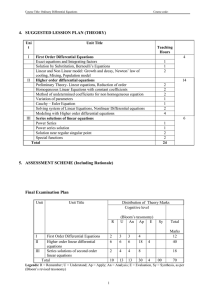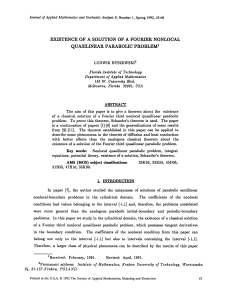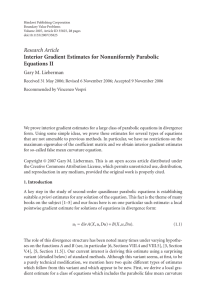Document 10514758
advertisement
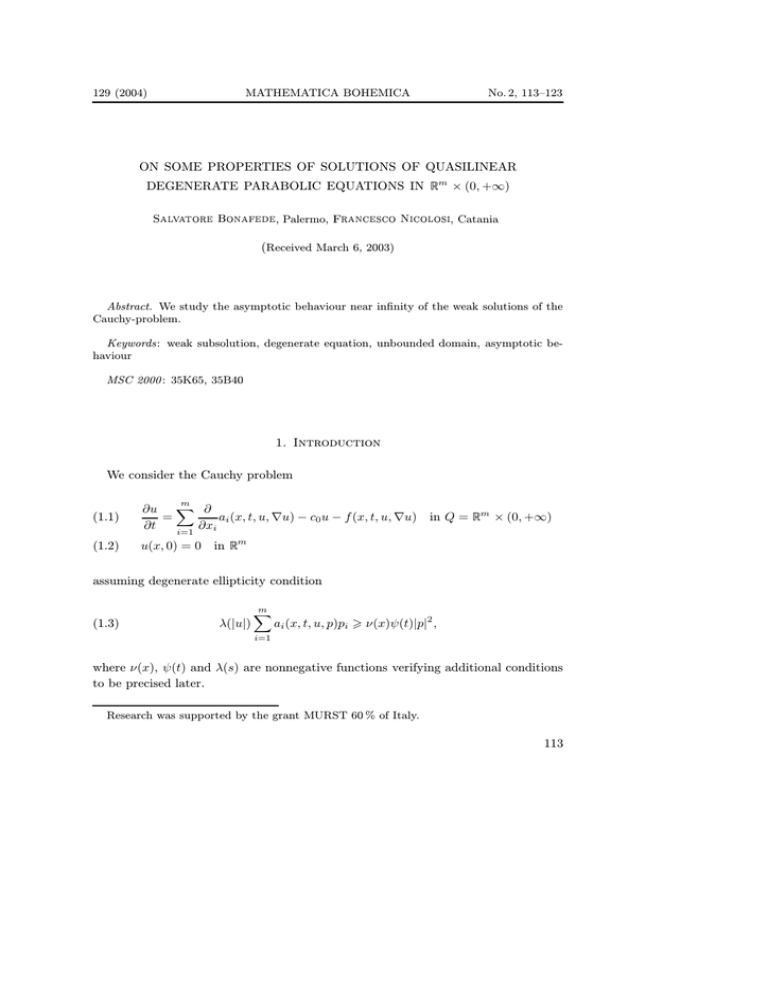
129 (2004)
MATHEMATICA BOHEMICA
No. 2, 113–123
ON SOME PROPERTIES OF SOLUTIONS OF QUASILINEAR
DEGENERATE PARABOLIC EQUATIONS IN
, Palermo,
m
× (0, +∞)
, Catania
(Received March 6, 2003)
Abstract. We study the asymptotic behaviour near infinity of the weak solutions of the
Cauchy-problem.
Keywords: weak subsolution, degenerate equation, unbounded domain, asymptotic behaviour
MSC 2000 : 35K65, 35B40
1. Introduction
We consider the Cauchy problem
m
(1.1)
∂u X ∂
=
ai (x, t, u, ∇u) − c0 u − f (x, t, u, ∇u) in Q =
∂t
∂xi
i=1
(1.2)
u(x, 0) = 0 in
m
× (0, +∞)
m
assuming degenerate ellipticity condition
(1.3)
λ(|u|)
m
X
ai (x, t, u, p)pi > ν(x)ψ(t)|p|2 ,
i=1
where ν(x), ψ(t) and λ(s) are nonnegative functions verifying additional conditions
to be precised later.
Research was supported by the grant MURST 60 % of Italy.
113
A model representative of (1.1) is as follows
m
∂u
∂u X ∂
|x|α tβ
− λ(x, t)u|u|p−2 ,
=
∂t
∂x
∂x
i
i
i=1
where 0 6 α < 2, β > 0, λ(x, t) ∈ L1 (Q)+ and p > 2.
At present time many results have been established concerning linear and quasilinear degenerate parabolic second or high-order equations. Existence and boundedness
of weak solutions of equations of the same class as in the present paper have already
been studied, for instance, in [2], [3], [4], [10] and [11]. For regularity results such as
Hölder continuity we refer the reader to [12]. Our goal is to study the asymptotic
behavior near infinity of any weak solution of the problem (1.1)–(1.2). Analogous
result for quasilinear degenerate elliptic equation is contained in [5], while results
concerning asymptotic properties of the weak solutions to the parabolic equation
m
∂u
∂u X ∂
ai,j (x, t)
+ a(x)u|u|p−2 = 0,
−
∂t
∂x
∂x
i
i
i=1
subject to the Neumann boundary condition, are obtained in [6] via comparison
principles.
2. Hypotheses and formulation of the main result
Let m denote the Euclidean m-space (m > 2) with generic point x = (x1 ,
x2 , . . . , xm ). We denote by QT the cylinder m × ]0, T [, T > 0.
Hypothesis 2.1. Let ν(x) be a positive and measurable function defined in Ω
such that:
m
g
∞
m
−1
m
ν(x) ∈ Lloc ( ), ν (x) ∈ Lloc ( )
g>
.
2
Hypothesis 2.2. Let ψ(t) be a positive measurable monotone nondecreasing
function defined in ]0, +∞[.
There exists a positive number g̃ such that 1/ψ ∈ Lg̃ (0, T ), ∀T > 0.
Assumptions (2.1), (2.2) are classical in the theory of weighted parabolic equations
(see [10] for more details).
The symbol W 1,0 (νψ, Q) stands for the set of all real valued functions u ∈ L2 (Q)
such that their derivatives (in the sense of distributions), with respect to xi , are
functions which have the following property
p
114
νψ
∂u
∈ L2 (Q), i = 1, 2, . . . , m.
∂xi
W 1,0 (νψ, Q) is a Hilbert space with respect to the norm
kuk1,0 =
Z Q
12
∂u 2
dx dt .
|u| +
νψ ∂xi i=1
2
m
X
W 1,1 (νψ, Q) is the subset of W 1,0 (νψ, Q) of all functions u such that ∂u/∂t (in
the sense of distributions) belongs to L2 (Q). We can suppose that any function of
W 1,1 (νψ, Q) is continuous in [0, +∞[ with respect to values in L2 ( m ).
Hypothesis 2.3. The functions f (x, t, u, p), ai (x, t, u, p) (i = 1, 2, . . . , m) are
Carathéodory functions in Q × × m , i.e. measurable with respect to (x, t) for any
(u, p) ∈ × m , continuous with respect to (u, p) for a.e. (x, t) in Q. λ : [0, +∞[ →
[1, +∞[ is monotone nondecreasing.
Hypothesis 2.4. There exists a function f ? (x, t) ∈ L1 (Q) such that
(2.1)
|f (x, t, u, p)| 6 λ(|u|) f ? (x, t) + ν(x)ψ(t)|p|2
holds for almost every (x, t) ∈ Q and for all real numbers u, p1 , p2 , . . . , pm .
Hypothesis 2.5. There exist a function f0 (x, t) ∈ L1 (Q) ∩ L∞ (Q) and a nonnegative real number c1 < c0 such that for almost every (x, t) ∈ Q and for all real
numbers u, p1 , p2 , . . . , pm the inequality
(2.2)
uf (x, t, u, p) + c21 + λ(|u|)ν(x)ψ(t)|p|2 + f0 (x, t) > 0
holds.
Hypothesis 2.6. There exists a function a? (x, t) ∈ L2 (Q) such that, for almost
every (x, t) ∈ Q, we have
(2.3)
p
|ai (x, t, u, p)|
√
6 λ(|u|)[a? (x, t) + νψ|p|]
νψ
for any real numbers u, p1 , p2 , . . . , pm .
Hypothesis 2.7. The condition (1.3) is satisfied for almost every (x, t) ∈ Q and
for all real numbers u, p1 , p2 , . . . , pm .
Hypothesis 2.8. For almost every (x, t) ∈ Q we have
(2.4)
m
X
i=1
[ai (x, t, u, p) − ai (x, t, u, q)] (pi − qi ) > 0
115
for any real numbers u, p1 , p2 , . . . , pm , q1 , q2 , . . . , qm ; the inequality holds if and only
if p 6= q.
Now, we are in position to give the definition of weak solution of the equation
(1.1).
Definition 1. A weak solution of the problem (1.1)–(1.2) in Q =
is a function u(x, t) ∈ W 1,0 (νψ, Q) ∩ L∞ (Q) such that the equality
(2.5)
Z
0
+∞Z
m
X
m
i=1
ai (x, t, u, ∇u)
∂w
∂w
+ c0 uw + f (x, t, u, ∇u)w − u
∂xi
∂t
m
× [0, +∞[
dx dt = 0
holds for any w ∈ W 1,1 (νψ, Q) ∩ L∞ (Q).
Under Hypotheses 2.1–2.8 the existence of a weak solution u of the equation (1.1)
follows from the results of [3], [4], [7], [8] and [9].
The following theorem states the asymptotic behavior of the solutions near infinity.
Theorem 2.1. Let Hypotheses 2.1–2.8 be satisfied and let R0 be a positive real
number such that
supp a? (x, t), supp f0 (x, t), supp f ? (x, t) ⊆ {x ∈
m
; |x| 6 R0 } × [0, +∞[.
Take a function u(x, t) ∈ W 1,0 (νψ, Q) ∩ L∞ (Q) which satisfies (2.5) for all w ∈
W 1,1 (νψ, Q) ∩ L∞ (Q). Then for any T > 0 there exist two positive constants β and
γ̃, depending on L = ess supQ |u(x, t)|, such that
(2.6)
γ̃(R−R0 )2
HR (T ) 6 β kf0 kL1 (QT ) + kf ? kL1 (QT ) e− η(R)T ψ(T )
∀R > R0 ,
where
HR (T ) =
Z
2
u (x, T ) dx +
|x|>R
Z TZ
0
|x|>R
and
η(R) =
sup
R<|x|<2R
116
ν(x).
νψ |∇u|2 dx dt,
3. Proof of Theorem 2.1
Let R > R0 , 0 < % 6 R and
0
|x| − R
ξ(x) = ξ(|x|) =
%
1
For fixed T > 0, we extend u(x, t) by zero in
we define
if |x| 6 R
if R < |x| < R + %
if |x| > R + %.
m
× ]−∞, +∞[ and for any n, s ∈ ,
if t 6 0
0
nt
if 0 < t 6 n1
Θn (t) = 1
if n1 < t 6 T
1 + n(T − t) if T < t 6 T + n1
0
if t > T + n1 ,
Z t+1/s
vns (x, t) = sΘn (t)
u(x, λ)|u(x, λ)|γ Θγ+1
n (λ) dλ
t
where γ > 0 will be chosen later.
Taking ξ 2 (x)vns (x, t) as test function in (2.5) we obtain
(3.1)
+∞Z
X
m
∂ 2
(ξ (x)vns ) + c0 uξ 2 (x)vns (x, t)
∂x
i
i=1
Z t+1/s
u(x, λ)|u(x, λ)|γ Θγ+1
(λ)
dλ
+ f (x, t, u, ∇u)ξ 2 (x)vns (x, t) − uξ 2 (x)Θ0 (t) s
n
Z
0
m
ai (x, t, u, ∇u)
t
Z t+1/s
∂
2
γ γ+1
− uξ (x)Θn (t)
s
u(x, λ)|u(x, λ)| Θn (λ) dλ
dx dt = 0.
∂t
t
We note that
∂vns
= sΘn (t)
∂xi
Z
t+1/s
t
∂
(u(x, λ)|u(x, λ)|γ ) Θγ+1
n (λ) dλ,
∂xi
so, according to the Hypothesis 2.2, we have
s 2
2
Z t+1/s
∂v ∂
ν(x)ψ(t) n 6 sν(x)
ψ(λ)
(u(x, λ)|u(x, λ)|γ ) dλ.
∂xi
∂xi
t
117
Moreover, it follows that
Z t+1/s
Z +∞Z
∂
2
γ γ+1
u(x, λ)|u(x, λ)| Θn (λ) dλ dx dt
m uξ (x)Θn (t) ∂t s t
0
γ
Z +∞Z
1 1 2
=s
m u(x, t)ξ (x)Θn (t) u x, t + s u x, t + s −∞
1
γ γ+1
γ+1
− u(x, t)|u(x, t)| Θn (t) dx dt
× Θn
t+
s
Z +∞Z
γ+2
1/(γ+2) Z +∞Z 1 γ+2 2
γ+2
6s
m |u(x, t)| ξ (x)Θn (t) dx dt
m u x, t + s −∞
−∞
γ+1
γ+2
Z +∞Z
1
2
γ+2
γ+2 2
γ+2
× ξ (x)Θn
t+
dx dt
−s
m |u(x, t)| ξ (x)Θn (t) dx dt = 0.
s
−∞
Then, from (3.1), letting s → +∞, we get
Z +∞Z X
m
∂
ai (x, t, u, ∇u)
(3.2)
u|u|γ ξ 2 (x) Θγ+2
n (t)
∂x
m
i
0
i=1
γ 2
γ+2
+ c0 |u|γ+2 ξ 2 (x)Θγ+2
n (t) + f (x, t, u, ∇u)u|u| ξ (x)Θn (t)
− |u|γ+2 ξ 2 (x)Θ0n (t)Θγ+1
n (t) dx dt 6 0.
On the other hand, for σ ∈ ]0, 1[, we have
Z +∞Z
γ+2 2
0
γ+1
(3.3)−
|u| ξ (x)Θn (t)Θn (t) dx dt
m
0
> −n
Z
0
1/nZ
m
|u|γ+2 ξ 2 (x) dx dt + n(1 − σ)γ+1
Z
T +σ/nZ
T
m
|u|γ+2 ξ 2 (x) dx dt.
Combining (3.2) and (3.3), for n → +∞, we obtain
Z TZ X
m
∂
(3.4)
u|u|γ ξ 2 (x) + c0 |u|γ+2 ξ 2 (x)
ai (x, t, u, ∇u)
∂xi
m
0
i=1
+ f (x, t, u, ∇u)u|u|γ ξ 2 (x) dx dt
Z
γ+1
+ (1 − σ)
σ |u(x, T )|γ+2 ξ 2 (x) dx 6 0.
m
Let us prove, for instance, that
Z +∞Z X
m
∂
lim
ai (x, t, u, ∇u)
u|u|γ ξ 2 (x) Θγ+2
n (t) dx dt
n→+∞ 0
∂xi
m
i=1
Z TZ X
m
∂
ai (x, t, u, ∇u)
u|u|γ ξ 2 (x) dx dt.
=
∂x
m
i
0
i=1
118
In fact
0
Θn (t) −→ 1
0
if t 6 0
if 0 < t < T
if t > T ;
moreover, the integration of the first term of the previous relation can be evaluated
in m × ]0, T + 1[ where a.e. we have
X
m
γ+2 ∂
γ 2
u|u|
ξ
(x)
Θ
(t)
a
(x,
t,
u,
∇u)
i
n
∂xi
i=1
6
m
X
i=1
∂
γ 2
|ai (x, t, u, ∇u)| u|u| ξ (x) ∀n ∈ .
∂xi
Then with respect to these facts, our assertion is true due to the Lebesgue theorem.
Next, choosing σ = (γ + 2)−1 and using the growth conditions in the right-hand
side of the inequality (3.4) we have
Z TZ
0
Z TZ
νψ
2 2
γ+2 2
m (γ + 1)|u| λ(L) |∇u| ξ (x) dx dt + (c0 − c1 ) 0 m |u| ξ (x) dx dt
Z
Z TZ
1
2 2
γ
γ+2 2
− λ(L)
m |u| νψ |∇u| ξ (x) dx dt + e(γ + 2) m |u(x, T )| ξ (x) dx
0
Z TZ X
Z TZ
m
∂ξ
γ 2
ai (x, t, u, ∇u)
|f
||u|
ξ
(x)
dx
dt
−
2
u|u|γ ξ(x) dx dt,
6
0
∂x
m
m
i
0
0
i=1
γ
and from this, for γ such that (γ + 1)/λ(L) − λ(L) > 1 (γ > 1),
(3.5)
Z TZ
0
6
2
m
|u|γ νψ |∇u| ξ 2 (x) dx dt +
Z TZ
0
+2
m
m
|u(x, T )|γ+2 ξ 2 (x) dx
|f0 ||u|γ ξ 2 (x) dx dt
Z TZ
0
Z
1
e(γ + 2) m
m
X
i=1
∂ξ γ+1
|u|
|ai (x, t, u, ∇u)| ξ(x) dx dt.
∂xi By Hypothesis 2.6 and the Young inequality it results
Z TZ X
m
∂ξ γ+1
|u|
|ai (x, t, u, ∇u)|
ξ(x) dx dt
m
∂x
i
0
i=1
Z TZ
Z Z
p
ε T
?
γ
νψ|u|
6 β1
a
ξ
|∇ξ|
dx
dt
+
|u|γ νψ |∇u|2 ξ 2 (x) dx dt
m
2 0 m
0
Z TZ
1
2
γ+2
+
νψ|u|
|∇ξ|
dx
dt
.
2ε 0 m
119
Hence, taking into account that supp a? (x, t) and supp f0 (x, t) are subsets of
{x ∈ m ; |x| 6 R0 } ×[0, +∞[, from (3.5) for ε > 0 sufficiently small, we obtain
Z TZ
(3.6)
0
2
m
|u|γ νψ |∇u| ξ 2 (x) dx dt 6 β2
Z TZ
0
2
m
νψ|u|2 |∇ξ| dx dt.
On the other hand, from (3.4) for γ = 0 and σ = 21 , we get
Z TZ
0
m
X
m
∂
2
2 2
2
uξ (x) + c0 u ξ (x) + f (x, t, u, ∇u)uξ (x) dx dt
ai (x, t, u, ∇u)
∂xi
i=1
Z
1
|u(x, T )|2 ξ 2 (x) dx 6 0.
+
2e m
From this, according to Hypotheses 2.4, 2.6 and 2.7, we have
1
λ(L)
Z TZ
Z
1
2 2
m νψ |∇u| ξ (x) dx dt + 2e m |u(x, T )| ξ (x) dx
0
Z TZ
γ1 Z TZ
γ−1
γ
2 2
2 2
γ
6 λ(L)
|u|
νψ
|∇u|
ξ
(x)
dx
dt
νψ
|∇u|
ξ
(x)
dx
dt
2 2
m
0
+ 2λ(L)
Z TZ
0
m
0
m
νψ |∇u| |u|ξ(x) |∇ξ| dx dt
and, after a simple calculation,
Z TZ
0
Z
2 2
νψ |∇u| ξ (x) dx dt + |u(x, T )|2 ξ 2 (x) dx
m
Z TZ
Z TZ
2 2
γ
6 β3
|u| νψ |∇u| ξ (x) dx dt + β4
m
0
m
0
m
νψ|u|2 |∇ξ|2 dx dt.
The above inequality and (3.6) give
Z TZ
0
Z
2 2
m
νψ |∇u| ξ (x) dx dt + m
|u(x, T )|2 ξ 2 (x) dx
Z TZ
6 β5
0
2
m
νψ|u|2 |∇ξ| dx dt;
in this way, by the definition of ξ(x), we get
(3.7)
β5
HR+% (T ) 6 2 ν(R, R + %)
%
where if R1 < R2 , ν(R1 , R2 ) =
sup
R1 <|x|<R2
120
Z
ν(x).
T
ψ(τ )HR (τ ) dτ,
0
Let us prove, by induction, the following inequality
(T ψ(T ))k
k
ν [(R + %, R0 + k%)] .
(3.8) HR0 +k% (T ) 6 β k kf0 kL1 (QT ) + kf ? kL1 (QT )
%2k k!
Our next claim is that to prove (3.8) where k = 0.
Choosing vns (x, t) as test function in (2.5) and proceeding analogously to the proof
of (3.4), we get
(3.9)
Z TZ
0
m
X
Z TZ
∂u γ
γ+2
|u|
dx
dt
+
c
0
m
m |u| dx dt
∂x
i
0
i=1
Z TZ
Z
1
γ
+
f
(x,
t,
u,
∇u)u|u|
dx
dt
+
|u(x, T )|γ+2 dx 6 0
e(γ
+
2)
m
m
0
(γ + 1)
ai (x, t, u, ∇u)
and from this for γ > λ2 (L) + λ(L) − 1
Z TZ
(3.10)
0
Z
1
|u(x, T )|γ+2 dx
m
e(γ + 2) m
γ Z TZ
6 ess sup |u|
|f0 (x, t)| dx dt.
|u|γ νψ |∇u|2 dx dt +
m×]0,+∞[
m
0
On the other hand if we write (3.9) for γ = 0 we obtain
1
λ(L)
Z TZ
0
2
m
6 λ(L)
νψ |∇u| dx dt +
Z TZ
0
+ λ(L)
Z
1
2e m
|u(x, T )|2 dx
2
m
[|f ? (x, t)| + νψ |∇u| ]|u| dx dt 6 Lλ(L)
Z TZ
0
2
m
|u|γ νψ |∇u| dx dt
γ1 Z TZ
0
Z TZ
0
m
|f ? (x, t)| dx dt
2
m
νψ |∇u| dx dt
γ−1
γ
.
Hence using the Young inequality we conclude that
Z TZ
0
m
νψ |∇u|2 dx dt +
6 β6
Z TZ
0
m
Z
1
2e |u(x, T )|2 dx
Z TZ
|f ? (x, t)| dx dt + β7
m
0
2
m
|u|γ νψ |∇u| dx dt
and finally, according to (3.10), that
(3.11)
HR0 (T ) 6 β kf0 kL1 (QT ) + kf ? kL1 (QT ) .
121
Let us assume that the inequality (3.8) holds for some integer k > 0. Due to (3.7)
and (3.8), we obtain
Z T
β
ψ(τ )HR0 +k% (τ )
HR0 +(k+1)% (T ) 6 2 ν (R0 + k%, R0 + (k + 1)%)
%
0
Z T
β
6 2 ν (R0 + k%, R0 + (k + 1)%)
ψ(τ )β k kf0 kL1 (QT ) + kf ? kL1 (QT )
%
0
k
(τ ψ(τ ))
k
[ν (R0 + k%, R0 + (k + 1)%)] dτ
%2k k!
β k+1
k+1 kf0 kL1 (QT ) + kf ? kL1 (QT )
= 2(k+1) [ν (R0 + k%, R0 + (k + 1)%)]
%
k!
Z T
k+1
×
τ k [ψ(τ )]
dτ.
×
0
According Hypothesis 2.1, taking into account that
ν (R0 + k%, R0 + (k + 1)%) 6
sup
ν(x),
R+%<|x|<R0 +(k+1)%
the last inequality implies (3.8) for k + 1. Let k > 1. Choosing in (3.8) % =
(R − R0 )/k we obtain
(T ψ(T ))k k 2k
k
[η(R)] .
HR (T ) 6 β k kf0 kL1 (QT ) + kf ? kL1 (QT )
2k
(R − R0 ) k!
From this inequality, using also Stirling’s formula, it follows that
(3.12)
β(R−R0 )2
HR (T ) 6 kf0 kL1 (QT ) + kf ? kL1 (QT ) e−k log ekη(R)T ψ(T ) .
Now, if
2
β (R − R0 )
6e
eη(R)T ψ(T )
the estimate (2.6) easily follows from (3.11). Otherwise, we can obtain (2.6) from
(3.12) taking as k the integer part of
122
β (R − R0 )2
.
e2 η(R)T ψ(T )
References
[1] Adams R. A.: Sobolev Spaces. Academic Press, New York, 1975.
[2] Bonafede S., Nicolosi F.: Control of essential supremum of solutions of quasilinear degenerate parabolic equations. Appl. Anal. 79 (2001), 405–418.
[3] Bonafede S., Nicolosi F.: Quasilinear degenerate parabolic equations in unbounded domains. Comm. Appl. Anal. 8 (2004), 109–124.
[4] Guglielmino F., Nicolosi F.: Existence results for boundary value problems for a class of
quasilinear parabolic equations. Actual problems in analysis and mathematical physics.
Proceedings of the interntional symposium, Taormina, Italy, 1992. Dipartimento di
Matematica, Università di Roma, pp. 95–117. (In Italian.)
[5] Kondratiev V., Nicolosi F.: On some properties of the solutions of quasilinear degenerate
elliptic equations. Math. Nachr. 182 (1996), 243–260.
[6] Kondratiev V., Véron, L.: Asymptotic behaviour of solutions of some nonlinear parabolic
or elliptic equations. Asymptotic Anal. 14 (1997), 117–156.
[7] Ladyzenskaja O. A., Solonnikov V. A., Ural’tseva N. N.: Linear and quasi-linear equations of parabolic type. Translation of mathematical monographs, vol. 23, A.M.S., Providence, 1968.
[8] Lions J. L.: Sur certains équations paraboliques non linéaires. Bull. Soc. Math. Fr. 93
(1965), 155–175.
[9] Nicolosi F.: Weak solutions of boundary value problems for parabolic operators that
may degenerate. Annali di Matematica 125 (1980), 135–155.
[10] Nicolosi F.: Boundary value problems for second-order linear degenerate parabolic operators. Le Matematiche 37 (1982), 319–327.
[11] Nicolosi F., Skrypnik I. V.: On existence and boundedness degenerate quasilinear
parabolic equations of higher order. Dopov. Akad. Nauk. Ukr. 1 (1997), 17–21.
[12] Nicolosi F., Skrypnik I. V.: Hölder continuity of solutions for higher order degenerate
nonlinear parabolic equations. Annali di Matematica 175 (1998), 1–27.
Authors’ addresses: Salvatore Bonafede, Dipartimento di Economia dei Sistemi AgroForestali, University of Palermo, Viale delle Scienze–90128 Palermo, Italy; Francesco Nicolosi, Department of Mathematics, University of Catania, Viale A. Doria 6–95125 Catania,
Italy.
123

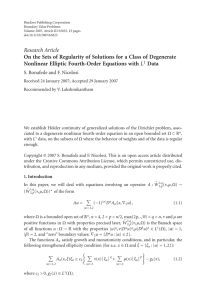



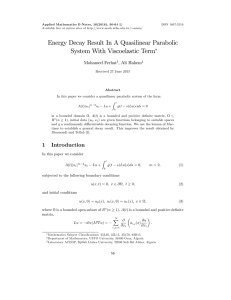
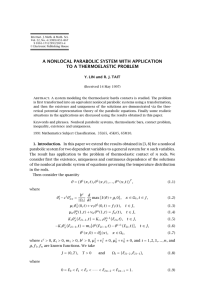
![Chem_Test_Outline[1]](http://s2.studylib.net/store/data/010130217_1-9c615a6ff3b14001407f2b5a7a2322ac-300x300.png)
